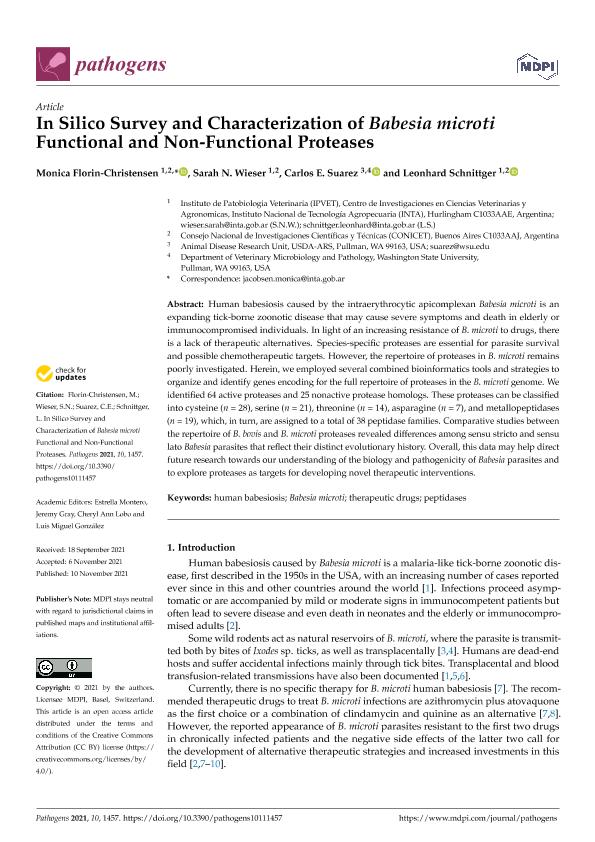Artículo
In silico survey and characterization of babesia microti functional and non-functional proteases
Fecha de publicación:
11/2021
Editorial:
Multidisciplinary Digital Publishing Institute
Revista:
Pathogens
e-ISSN:
2076-0817
Idioma:
Inglés
Tipo de recurso:
Artículo publicado
Clasificación temática:
Resumen
Human babesiosis caused by the intraerythrocytic apicomplexan Babesia microti is an expanding tick-borne zoonotic disease that may cause severe symptoms and death in elderly or immunocompromised individuals. In light of an increasing resistance of B. microti to drugs, there is a lack of therapeutic alternatives. Species-specific proteases are essential for parasite survival and possible chemotherapeutic targets. However, the repertoire of proteases in B. microti remains poorly investigated. Herein, we employed several combined bioinformatics tools and strategies to organize and identify genes encoding for the full repertoire of proteases in the B. microti genome. We identified 64 active proteases and 25 nonactive protease homologs. These proteases can be classified into cysteine (n = 28), serine (n = 21), threonine (n = 14), asparagine (n = 7), and metallopeptidases (n = 19), which, in turn, are assigned to a total of 38 peptidase families. Comparative studies between the repertoire of B. bovis and B. microti proteases revealed differences among sensu stricto and sensu lato Babesia parasites that reflect their distinct evolutionary history. Overall, this data may help direct future research towards our understanding of the biology and pathogenicity of Babesia parasites and to explore proteases as targets for developing novel therapeutic interventions.
Palabras clave:
BABESIA MICROTI
,
HUMAN BABESIOSIS
,
PEPTIDASES
,
THERAPEUTIC DRUGS
Archivos asociados
Licencia
Identificadores
Colecciones
Articulos (IPVET)
Articulos de INSTITUTO DE PATOBIOLOGIA VETERINARIA
Articulos de INSTITUTO DE PATOBIOLOGIA VETERINARIA
Citación
Florin Christensen, Mónica; Wieser, Sarah Nathaly; Suarez, Carlos E.; Schnittger, Leonhard; In silico survey and characterization of babesia microti functional and non-functional proteases; Multidisciplinary Digital Publishing Institute; Pathogens; 10; 11; 11-2021; 1-26
Compartir
Altmétricas




